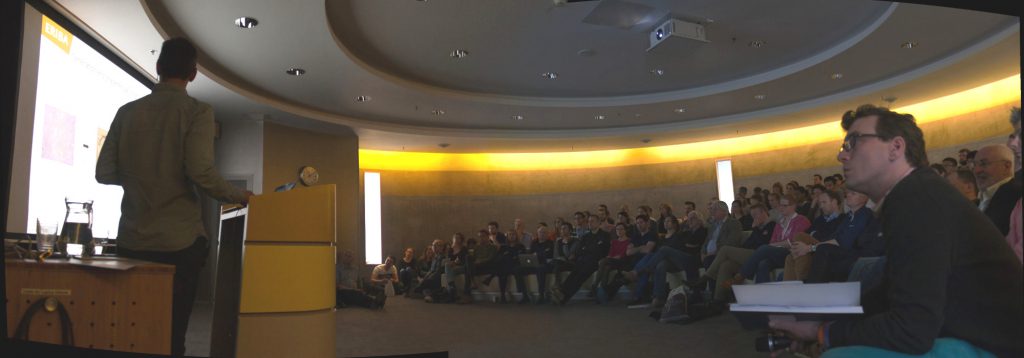Introducing the new iPSC CRISPR Facility
On April 28 a very successful opening symposium marked the official start of the ERIBA iPSC CRISPR Facility. About a hundred people enjoyed lectures on the history and latest developments of iPS-cell and CRISPR-Cas9 technology. The symposium was concluded with an opening speech by the UMCG dean of research Erik Boddeke and a collective toast. Now the real work for the facility can begin!
Over the past few months, the new iPSC CRIPSR Facility materialized at ERIBA. First to start was senior technician Mathilde Broekhuis, briefly followed by the arrival of senior postdoc Daniël Warmerdam in January this year. With the arrival of senior postdoc Stefan Juranek in April, the team is (for now) complete. Over the last few weeks the facility caught considerable public interest despite the recent kickoff. This included an interview with the UMCG online magazine ‘KennisInZicht’ (in Dutch), the launch of the facility website and an interview with Daniël on Radio Noord. At the time of the opening symposium it already seemed impossible to imagine ERIBA without the iPSC CRISPR Facility.
So, what does the facility do exactly? The three researchers working at the facility form a specialized team that can provide advice, training and experimental help with two types of research. The first is the isolation and reprogramming of differentiated human cells to so-called induced Pluripotent Stem Cells (iPSC). The second is genome editing using Clustered Regularly Interspaced Short Palindromic Repeats-associated nucleases (CRISPR-Cas9). Combining the two (the ultimate mission of the facility) is expected to lead to personalized therapies that fight human disease in the future. To accomplish this ultimate goal, the iPSC CRISPR Facility particularly welcomes iPSC/CRISPR-combined projects. Importantly, as a research facility, there will be a constant interest for new developments and new applications, for which the facility will collaborate with various UMCG and RUG groups. As such the facility will not only use its own expertise, but they will also further expand this at the same time.
The festive opening symposium showed the broad spectrum of applications of both iPSC and CRISPR-Cas9 technologies. It thus emphasized the huge impact both techniques have a huge impact on Life sciences. The staggering number of papers being published that successfully use these technologies every week, as highlighted in Daniël Warmerdam’s presentation, argues the same. The impact of iPSC on disease modelling became very clear from the opening lecture by Sjef Copray, the pioneer of iPSC culture at the UMCG. Although Sjef is about to retire, his expertise will continue in the iPSC CRISPR Facility. The symposium was concluded by a keynote lecture by Steven Pollard on how epigenetic reprogramming and CRISPR can help to understand cancer. And even though the symposium was running late, Steven was able to captivate the audience until the end.
Finally, a few kind words by the dean of research combined with a glass of bubbles in the ERIBA Science Hall marked the official opening of the facility. A well-suited conclusion to an afternoon of scientific marvels. Because whether you’d be considering the generation of iPS cell lines from a 105 your old patient or using iPS cells to predict the progress of a very rare disease in a young patient: the possibilities really speak to the imagination. The iPSC CRISPR Facility has high expectations to live up to, but fortunately a world of wonder to explore as well.
Back to previous page





